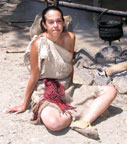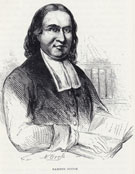Study Guide Household

Table of Contents
Clothing
 In the artwork and imagination of later generations, Puritans are usually depicted in all black clothes with large buckles, and the Natives they meet usually wear buckskin with a single feather decorating the back of their heads. Neither of these representations is entirely accurate. The actors at Plimoth Plantation have tried to reshape our conceptions of attire through careful attention to the actual historical record (right and below). While Puritans did feel that plain, dark clothing made from wool or cotton reflected their plain style ideals (Rubinstein 286), Puritan clothing could be brightly colored and included the use of yellow, green, red, and even purple, and for wealthy Puritans ornamentation was not unusual, as the painting of Elizabeth and Baby Mary Freake, (1674, Worcester Art Museum) illustrates. Although some have argued that this ornamentation was a sign of the Freakes' lack of commitment to Puritanism (Craven 1-11), this does not seem to have been the case. The sumptuary laws of Massachusetts Bay did not prevent all extravagance in clothing, but rather limited it to people with estates greater than £200 (Earle 17). In this way, clothing communicated one's position, economic achievement, and social standing (Welters 13). For example, Puritan divine John Winthrop, author of “A Model of Christian Charity,” had several dozen scarlet coats imported from England (Rubinstein 88). Indeed, the Freake family was well known for their piety. John Freake, Elizabeth's first husband, was a trustee of the Second Church of Boston, and Elizabeth became a member of the church in 1691. Puritan divine Samuel Sewall mentions Elizabeth as a “woman of faith”: her uprightness is mirrored in the stiff and somber pose.
In the artwork and imagination of later generations, Puritans are usually depicted in all black clothes with large buckles, and the Natives they meet usually wear buckskin with a single feather decorating the back of their heads. Neither of these representations is entirely accurate. The actors at Plimoth Plantation have tried to reshape our conceptions of attire through careful attention to the actual historical record (right and below). While Puritans did feel that plain, dark clothing made from wool or cotton reflected their plain style ideals (Rubinstein 286), Puritan clothing could be brightly colored and included the use of yellow, green, red, and even purple, and for wealthy Puritans ornamentation was not unusual, as the painting of Elizabeth and Baby Mary Freake, (1674, Worcester Art Museum) illustrates. Although some have argued that this ornamentation was a sign of the Freakes' lack of commitment to Puritanism (Craven 1-11), this does not seem to have been the case. The sumptuary laws of Massachusetts Bay did not prevent all extravagance in clothing, but rather limited it to people with estates greater than £200 (Earle 17). In this way, clothing communicated one's position, economic achievement, and social standing (Welters 13). For example, Puritan divine John Winthrop, author of “A Model of Christian Charity,” had several dozen scarlet coats imported from England (Rubinstein 88). Indeed, the Freake family was well known for their piety. John Freake, Elizabeth's first husband, was a trustee of the Second Church of Boston, and Elizabeth became a member of the church in 1691. Puritan divine Samuel Sewall mentions Elizabeth as a “woman of faith”: her uprightness is mirrored in the stiff and somber pose.
 Wampanoag clothing was also more varied that is usually suggested by nineteenth- and twentieth-century artwork. While clothing was often made from white tail deerskins, other animals' skins and fur were also used including moose, elk, harbor seal, black bear, raccoon, river otter, grey and red fox, grey squirrel, beaver, muskrat and even the eastern timber wolf. An outer robe of fur hung over the shoulder was common for both men and women. For high status individuals such as sachems or pennies, bird feathers were used to make robes (Nanpashamet). Wampanoags of high status displayed their power by wearing wampum (shell currency) and other valuable items which showed their "lack of immediate need for...money" (Marten 19; Bragdon 171) In Mary Rowlandson's captivity narrative ornamentation is used by various sachems to reinforce their status before their people and the British. For example, when Weetamoo, a squa-sachem, meets with a British emissary to discuss Rowlandson's release, she wears "a Kersey coat...covered with Girdles of Wampom from the loins upward." At the same meeting Quanopen's "Garters were hung round with shillings; and he had Girdles of Wampom upon his Head and Shoulders" (Rowlandson 58). The message of power embodied in this ornamentation was sometimes lost on the British: for Rowlandson, Weetamoo's obsession with dress signifies her sinful "Pride," not her increased status. For the Wampanoags, though, Weetamoo's jewelry and intricate clothing was not only acceptable for a leader, but also expected and necessary for the preservation of her status within the tribe (Arnold).
Wampanoag clothing was also more varied that is usually suggested by nineteenth- and twentieth-century artwork. While clothing was often made from white tail deerskins, other animals' skins and fur were also used including moose, elk, harbor seal, black bear, raccoon, river otter, grey and red fox, grey squirrel, beaver, muskrat and even the eastern timber wolf. An outer robe of fur hung over the shoulder was common for both men and women. For high status individuals such as sachems or pennies, bird feathers were used to make robes (Nanpashamet). Wampanoags of high status displayed their power by wearing wampum (shell currency) and other valuable items which showed their "lack of immediate need for...money" (Marten 19; Bragdon 171) In Mary Rowlandson's captivity narrative ornamentation is used by various sachems to reinforce their status before their people and the British. For example, when Weetamoo, a squa-sachem, meets with a British emissary to discuss Rowlandson's release, she wears "a Kersey coat...covered with Girdles of Wampom from the loins upward." At the same meeting Quanopen's "Garters were hung round with shillings; and he had Girdles of Wampom upon his Head and Shoulders" (Rowlandson 58). The message of power embodied in this ornamentation was sometimes lost on the British: for Rowlandson, Weetamoo's obsession with dress signifies her sinful "Pride," not her increased status. For the Wampanoags, though, Weetamoo's jewelry and intricate clothing was not only acceptable for a leader, but also expected and necessary for the preservation of her status within the tribe (Arnold).
 For Christian converts, wearing European-style clothing such as that worn by minister Samson Occom (right) was an important symbol of both one's relationship to Christianity as well as of one's social status. Throughout Native New England, European clothing was a highly valued resource for both men and women, as noted in the David Fowler's letters to Eleazer Wheelock. As Daniel Gookin, Superintendent of the Indians of Massachusetts Bay Colony from 1656 to 1687, notes “The Christian and civilized Indians do endeavour, many of them, to follow the English mode in their habit.” This meant both cutting one's hair and wearing “cloth suits, stockings, and cobbled shoes” (Welters 15). Puritans favored short cropped-hair (known as a “Roundhead”), particularly for the lower classes, and shoulder-length hair for merchants and the upper classes (Craven 5). Longer hair was associated with the Cavalier society and was seen as “a vile abuse…an incitation to lust…and Sodomy” (Craven quotes William Pyrnne 5). In hisportrait, Samson Occom's hair is of a modest and unlustful length, and is worn in a style similar to that of puritan John Freake (The Freake Limner, John Freake, 1674; Worchester Art Museum).
For Christian converts, wearing European-style clothing such as that worn by minister Samson Occom (right) was an important symbol of both one's relationship to Christianity as well as of one's social status. Throughout Native New England, European clothing was a highly valued resource for both men and women, as noted in the David Fowler's letters to Eleazer Wheelock. As Daniel Gookin, Superintendent of the Indians of Massachusetts Bay Colony from 1656 to 1687, notes “The Christian and civilized Indians do endeavour, many of them, to follow the English mode in their habit.” This meant both cutting one's hair and wearing “cloth suits, stockings, and cobbled shoes” (Welters 15). Puritans favored short cropped-hair (known as a “Roundhead”), particularly for the lower classes, and shoulder-length hair for merchants and the upper classes (Craven 5). Longer hair was associated with the Cavalier society and was seen as “a vile abuse…an incitation to lust…and Sodomy” (Craven quotes William Pyrnne 5). In hisportrait, Samson Occom's hair is of a modest and unlustful length, and is worn in a style similar to that of puritan John Freake (The Freake Limner, John Freake, 1674; Worchester Art Museum).
David Fowler, a Montauk Indian and brother-in-law of Mohegan minister Samson Occom, then was not alone in wanting European cloth and clothes: as historian David Silverman argues, by the beginning of the eighteenth century, neither the colonists nor Christianized Indians found clothing made of animal skins acceptable. Indeed, between 1720 and 1752, clothing and cloth made up 16% of the purchases at Vineyarder John Allen's store, and between 1759 to 1765 it was 86% of the purchases at Peter Norton's store (Silverman 325-27). Even by the time of King Philip's War (1675-76), non praying-Indians were acquiring European clothes either through trade or as state gifts from colonists, and they tended to view these objects as status markers. Indeed clothing was so important that it was even bequeathed in wills. The most common articles mentioned in colonial records are coats, usually red ones, and stockings, shoes, and shirts (Welters 16). Red was a color often worn by government officials and hence was given as a sign of respect to Algonquian leaders such as Wampanoag sachem Massasoit (Mourt's Relation, 1622; cited in Welters 16). Occom's portrait depicts, ministers usually wore black with a small white bib-like collar. For the Puritans colors were symbolic: “black was indicative of solid respectability, blue was frequently worn by children and servants, and russet (reddish-brown) was a countryman's color." (“Plymouth Colony Clothing"). As sociologist Ruth Rubenstein notes, somber attire such as that worn by ministers was intended to avoid being distracting “so that people could better focus on the task at hand. The clothing was designed to represent mastery over one's feelings and to demonstrate rationality, the state of making decisions on the basis on calculation, organization, abstract rules, and procedures.” This ideal became the model for the professional mens' attire of plain dark suit that is still common today (Rubinstein 45).
By 1698 when the Society for the Propagation of the Gospel visited the Wampanoag converts at Mashpee, 263 of the members of the community were wearing English-style clothing (Welters 23). For men who weren't ministers, this generally meant shoes, linen shirts, breeches, and if possible a padded doublet, and a loose-fitting cape or coat. English-style women's clothing included a shirt-like undergarment called a “shift,” and either an outer dress or a fitted jacket and skirt. Women usually covered their hair. Once children reached the age of seven, they tended to be dressed as little adults.
Items Related to Clothing in the Archive
Food < Previous